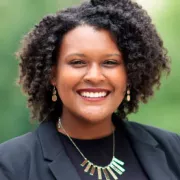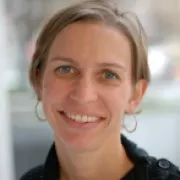Enhancing Women’s Agency

Improving women’s agency, namely their ability to define goals and act on them, is crucial for advancing gender equality and the empowerment of women. Women’s financial inclusion interventions have traditionally focused on narrowing the access gap, but there is a growing recognition these interventions need to go beyond measuring access and use to get at what really matters – increased voice and agency. When a woman has agency, she can make more informed and better financial choices for herself and her family based on her own vision of the future. However, this is not without challenges given the complex nature of agency. Agency is hard to define, can change based on context and individual, and is often inhibited by deeply held social norms. Drawing on the findings from J-PAL’s recent literature review and the SEEP Network’s WEE WG publication, the webinar looked at when and how financial inclusion interventions can promote agency and how best to measure it.
QUESTIONS FROM THE Q&A SESSION (Participant questions not answered during the live portion of the webinar due to lack of time.)
Q: Does the dynamics piece include joint vs sole decision-making?
Yes, dynamics can be within oneself as well as between others. This often arises in household decision making and when measured, it is often addressed in the decision making metrics that organizations use to measure agency in households.
Q: Could you please throw some light on if and how the microfinance programs have helped in increasing women's agency in the household decision making, her status, reduction in domestic violence etc.? Thank you!
Microfinance, and other financial inclusion initiatives, had limited effects on measures of women's agency, including household decision-making, business outcomes. That said, there is also strong evidence that economic interventions such as microcredit, transfers, and savings groups when coupled with trainings, discussions, or coaching that addressed gender dynamics explicitly were effective in improving women’s agency. For example, the IMAGE program, a microfinance-based program that integrated training on gender and HIV in South Africa, reduced IPV only women receiving a gender training in addition to microfinance services (Kim et al. 2009).
Q: What do you think is the value (if there is value) as a community to distinguish between agency and empowerment?
Yes, they are linked but different, so it is useful to make a distinction. In the SEEP brief (https://seepnetwork.org/files/galleries/2019-WEE-MeasuringWomensAgency-_EN-DIGITAL.pdf), you can find how we decided to define empowerment and agency, building off of Naila Kabeer’s definitions.
Q: In the Indian example of "a program which opened accounts in women's name", what specific evidence did you see in terms of improved agency for women? And how did it address their power balance with men?
This intervention (depositing government workfare payments into accounts in women's names, plus training women how to use the account) increased women's labor force participation and mobility, as well as improved attitudes about restrictive gender norms. However, this intervention had no effect on women’s role in decisions about her employment and spending her earnings. While men’s gender attitudes remained unchanged, their acceptance of women in the community working significantly increased. Researchers posited that women’s enhanced bargaining power stemming from control over their wage payments enabled them to push back against limiting gender norms.
Q: Can you speak more about the 4 studies showing positive results from soft skills in business training?
These trainings combined standard business training material with additional training content on topics such as women’s self-confidence, gender equality, or agency.
Q: Are there any macroeconomic indicators that can help understand a broader picture of women's agency in a country?
• https://wbl.worldbank.org/
• In the SEEP paper we reference SIGI, and UN Women. There is also Data2x.
Q: Should the definition of "women's agency" also include and track the perception of men about how they view a woman's role in the household and the communities?
Agree. It is critical to engage men, as discussed in the J-Pal paper, but it has to be done really well to make any kind of change. Additional insights in the ICRW’s paper on Gender Equity and Male Engagement (https://www.icrw.org/publications/gender-equity-male-engagement/) Women for Women also has a nice piece on men’s engagement for reference (https://www.womenforwomen.org.uk/sites/default/files/Files/WfWI%20MEP%20leave%20behind%20 V4.pdf)
Q: Did you ask women themselves what "more agency" meant for them? what decisions weren't they able to make and were important to them?
Yes, the Jordan Valley Links and AWID examples that we shared do exactly this. You can find links to the resources in the SEEP brief.
Now a question for you: we'd like to know what information was useful to you and what, if any, questions remain. Please fill out our survey - responses will inform additional learning activities on this topic within FinEquity.
About this event

Mikaela Rabb
Mikaela Rabb is a Policy Associate at J-PAL, where she supports both the Gender and Finance sectors. In this position, she writes policy publications and connects with policymakers to support the use of evidence in development practices. Prior to joining J-PAL, she interned in management consulting with a focus on the public sector. As an undergraduate, she worked with the Liberian Ministry of Health and Clinton Health Access Initiative (CHAI) to improve medical education in Liberia. Mikaela holds a bachelor’s degree from Yale University with a double major in global affairs and ethnicity, race, and migration.

Anna Mecagni
Anna Mecagni is the Senior Director for Program Design and Development at Women for Women International. She brings 20 years of experience supporting inclusive development with marginalized populations. At WfWI, she guides integrated programs supporting marginalized women in conflict-affected countries. WfWI’s programs include social and economic development through women’s rights and health education, cash transfers, business and vocational training, savings and lending groups, men’s engagement, and grassroots advocacy. Previously, Ms. Mecagni managed civil society strengthening, youth development and refugee rights programs with FHI 360, IRC, and Human Rights First. She earned a Masters degree at the Fletcher School at Tufts University and has enjoyed life and work experience in Senegal, Chad, Burundi and Mozambique.

Diana Dezso
Diana Dezso leads the Data and Measurement Working Group of FinEquity. Diana has 20 years of experience in the financial inclusion sector. She specializes in knowledge management, organizational development and learning, capacity assessments, program implementation and evaluation, and new business development. She has worked in senior leadership positions of international organizations in both Washington DC and the field, including the SEEP Network and ACCION USA. Diana has an MPA from New York University.